
The Mimosoideae are a traditional subfamily of trees, herbs, lianas, and shrubs in the pea family (Fabaceae) that mostly grow in tropical and subtropical climates. They are typically characterized by having radially symmetric flowers, with petals that are twice divided (valvate) in bud and with numerous showy, prominent stamens.

The Fabaceae or Leguminosae, commonly known as the legume, pea, or bean family, are a large and agriculturally important family of flowering plants. It includes trees, shrubs, and perennial or annual herbaceous plants, which are easily recognized by their fruit (legume) and their compound, stipulate leaves. The family is widely distributed, and is the third-largest land plant family in number of species, behind only the Orchidaceae and Asteraceae, with about 765 genera and nearly 20,000 known species.

The Faboideae are a subfamily of the flowering plant family Fabaceae or Leguminosae. An acceptable alternative name for the subfamily is Papilionoideae, or Papilionaceae when this group of plants is treated as a family.
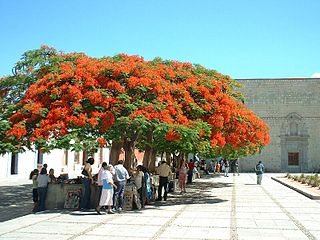
Caesalpinioideae is a botanical name at the rank of subfamily, placed in the large family Fabaceae or Leguminosae. Its name is formed from the generic name Caesalpinia. It is known also as the peacock flower subfamily. The Caesalpinioideae are mainly trees distributed in the moist tropics, but include such temperate species as the honeylocust and Kentucky coffeetree. It has the following clade-based definition:
The most inclusive crown clade containing Arcoa gonavensisUrb. and Mimosa pudicaL., but not Bobgunnia fistuloides(Harms) J. H. Kirkbr. & Wiersema, Duparquetia orchidaceaBaill., or Poeppigia proceraC.Presl
In biological classification, a subfamily is an auxiliary (intermediate) taxonomic rank, next below family but more inclusive than genus. Standard nomenclature rules end botanical subfamily names with "-oideae", and zoological subfamily names with "-inae".
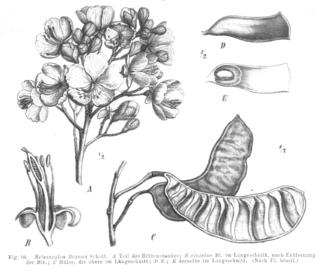
Melanoxylum is genus of plants in the legume family, Fabaceae. It includes a single species, Melanoxylum brauna, the yellow-flowered brauna tree. It is native to eastern Brazil. The genus is part of subfamily Caesalpinioideae.

The subfamily Detarioideae is one of the subdivisions of the plant family Fabaceae (legumes). This subfamily includes many tropical trees, some of which are used for timber or have ecological importance. The subfamily consists of 84 genera, most of which are native to Africa and Asia. Pride of Burma and tamarind are two of the most notable species in Detarioideae. It has the following clade-based definition:
The most inclusive crown clade containing Goniorrhachis marginataTaub. and Aphanocalyx cynometroidesOliv., but not Cercis canadensisL., Duparquetia orchidaceaBaill., or Bobgunnia fistuloides(Harms) J. H. Kirkbr. & Wiersema.

Storckiella is a genus of four recognised species of trees, of the plant family Fabaceae. It belongs to the subfamily Dialioideae. They grow naturally in New Caledonia, Fiji and Australia.

Galegeae is a tribe in the flowering plant family Fabaceae, subfamily Faboideae. The tribe is found mostly in the northern hemisphere, but can also be found in Australia, Africa, and South America. Recent molecular phylogenetic work has determined that tribe Galegeae is paraphyletic, and that its members are scattered throughout the IR-lacking clade.

Peltophorum is a genus of 5–15 species of flowering plants in the family Fabaceae, subfamily Caesalpinioideae. The genus is native to certain tropical regions across the world, including northern South America, central and southern Africa, Indochina, southeastern China, Malesia, New Guinea, and northern Australia. The species are medium-sized to large trees growing up to 15–25 m tall, rarely 50 m.
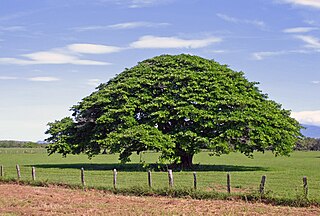
Enterolobium is a genus of 12 species of flowering plants in the family Fabaceae, native to tropical and warm-temperate regions of the Americas. They are medium-sized to large trees.
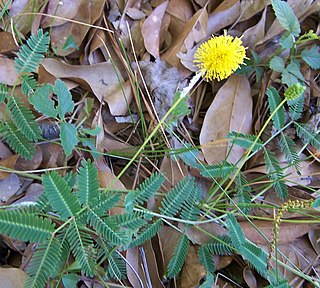
Neptunia is a genus of flowering plants in the family Fabaceae. It belongs to the mimosoid clade of the subfamily Caesalpinioideae.

Cercidoideae is a subfamily in the pea family, Fabaceae. Well-known members include Cercis (redbuds), including species widely cultivated as ornamental trees in the United States and Europe, Bauhinia, widely cultivated as an ornamental tree in tropical Asia, and Tylosema, a semi-woody genus of Africa. The subfamily occupies a basal position within the Fabaceae and is supported as monophyletic in many molecular phylogenies. At the 6th International Legume Conference, the Legume Phylogeny Working Group proposed elevating the tribe Cercidae to the level of subfamily within the Leguminosae (Fabaceae). The consensus agreed to the change, which was fully implemented in 2017. It has the following clade-based definition:
The most inclusive crown clade containing Cercis canadensisL. and Bauhinia divaricataL. but not Poeppigia proceraC.Presl, Duparquetia orchidaceaBaill., or Bobgunnia fistuloides(Harms) J.H.Kirkbr. & Wiersema.
Diptychandra is a genus of flowering plants in the legume family, Fabaceae. It belongs to the subfamily Caesalpinioideae. It includes two species native to northern South America, ranging from Colombia to Bolivia, Paraguay, and southeastern Brazil.

Recordoxylon is a genus of flowering plants in the legume family, Fabaceae. It belongs to the subfamily Caesalpinioideae. Currently, there is no commercial usage for it, not as decoration nor for its nutritive properties.

Dicorynia is a genus of flowering plants in the legume family, Fabaceae. It belongs to the subfamily Dialioideae. It includes two species of trees native to northern South America, ranging through Peru, Colombia, Venezuela, the Guianas, and northern Brazil.
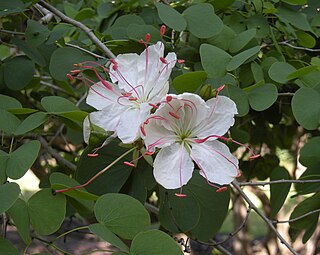
Lysiphyllum is a genus of flowering plants in the legume family, Fabaceae. It includes nine species of trees, semi-scandent shrubs, and lianas which range from India through Myanmar and Thailand to Peninsular Malaysia, Borneo, the Philippines, Java, the Lesser Sunda Islands, New Guinea, the Bismarck Archipelago, and Australia. Typical habitats include seasonally-dry tropical forest and woodland, vine thickets, Brigalow and Gidgee scrubland, floodplains, alluvial flats, tidal forest, mangroves, river and stream banks, and occasionally dunes and coral islets. They can grow on diverse soils including calcareous, granitic, and basaltic.

Piliostigma is a genus of flowering plants in the legume family, Fabaceae. It includes five species of small deciduous trees native to sub-Saharan Africa, the Indian subcontinent, Indochina, Java, the Philippines, and northern Australia. It belongs to the subfamily Cercidoideae and the tribe Bauhinieae. It is dioecious, with male and female flowers on separate plants.
Cathormion is a genus of flowering plants in the family Fabaceae. It contains a single species, Cathormion umbellatum, a shrub or tree which ranges from India to Indochina, Sumatra, Java, Sulawesi, the Lesser Sunda Islands, Maluku, New Guinea, and northern Australia.

The subfamily Dialioideae is one of the subdivisions of the plant family Fabaceae (legumes). This subfamily includes many tropical trees and shrubs. The subfamily consists of 17 genera, which are widespread throughout the tropics. It has the following clade-based definition:
The most inclusive crown clade containing Poeppigia proceraC.Presland Dialium guianense(Aubl.) Sandwith, but not Cercis canadensisL., Duparquetia orchidaceaBaill., or Bobgunnia fistuloides(Harms) J. H. Kirkbr. & Wiersema

















